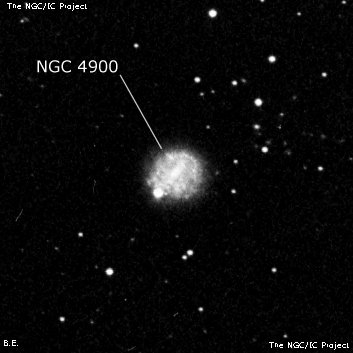
William Herschel discovered NGC 4900 = H I-143 = h1509 on 30 Apr 1786 (sweep 558) amd recorded "cB, just np a pB star and joining it as to appear like a brush to it." In his 1814 PT paper he used this example and others to demonstrate a supposed union or attraction between the star and the nebula. JH made three observations and one description notes a "star 11m, with a fan or brush."
R.J. Mitchell, observing with LdR's 72" on 18 Apr 1855, recorded "Looks sometimes like the owl nebula when badly seen, with a B, E patch in centre and dark spots on each side of this; sometimes dark ring is seen all the way round, but blackest to [sp and nf]. Neby round is mottled." On 24 Apr 1857 he logged "B centre is elongated in the direction of the star on edge and on either side of centre there certainly exist dark spaces as before remarked, giving it the look of the owl-neb. Yet I sometimes thought I saw it as a sprial with a break in outer annulus npp." The barred-ring structure in his sketch can be verified on the SDSS!
200/250mm - 8" (5/21/82): fairly bright, small. Unusual appearance with a mag 10 star attached at the east edge and the galaxy extends to the west.
400/500mm - 17.5" (5/22/93): fairly bright, moderately large, round, 1.5' diameter. A mag 10.5 star is attached at the SE edge 41" from center. Even surface brightness except for a faint slightly elongated "knot" just NW of center which may be the central bar or an offset nucleus.
900/1200mm - 48" (4/7/13): this unusual galaxy visually appears like a barred ring. At 488x a bright nucleus is embedded with a weak bar, extending NW-SE. A slightly brighter knot is situated close northwest of the nucleus. A mag 11 star is attached at the southeast end of the galaxy, collinear with the "bar". A large, round halo extends 1.7' and is slightly brighter along portions of the outer edge, forming a weak ring with a slightly darker interior on either side of the bar.
Notes by Steve Gottlieb